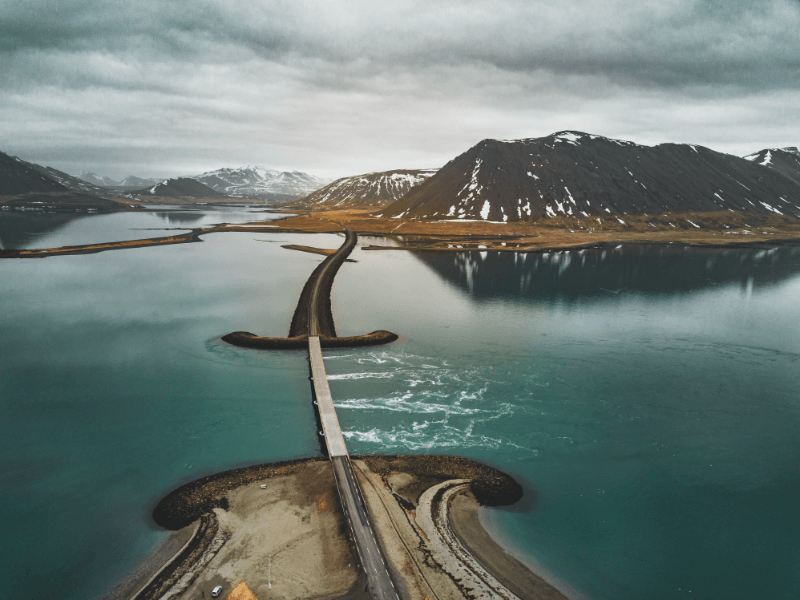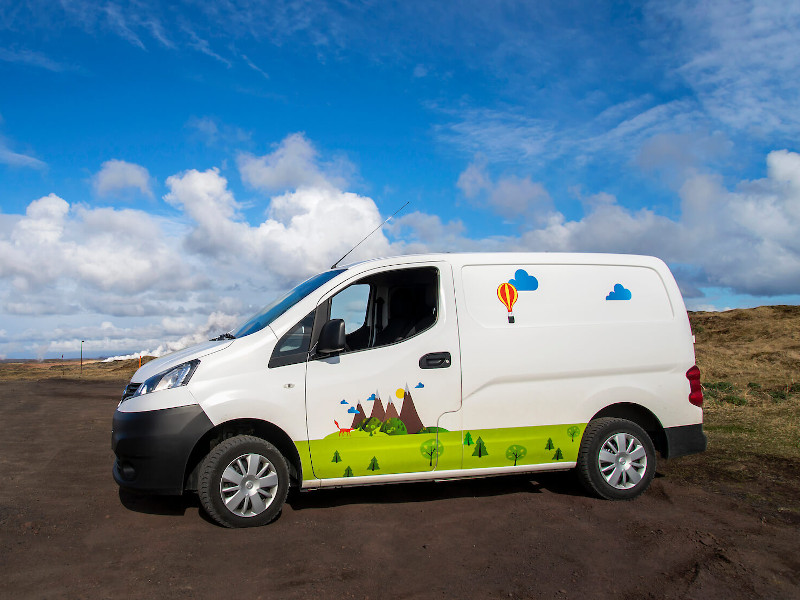Driving in Norway isn't as simple as just hopping in a car and hitting the road. Strict speed limits, expensive toll roads, endless tunnels, and unpredictable weather can catch you off guard.
Gas stations aren't always easy to find, and if you're renting a campervan, there's even more to think about. This guide covers road rules, common challenges, and essential tips so you can drive with confidence and avoid costly mistakes.
What Side of the Road Does Norway Drive On
Norway's driving side rules are straightforward. Norway drives on the right side of the road, like most of Europe and the United States. Overtaking happens on the left, and traffic laws are strictly enforced. If you're used to left-side driving, be extra careful at intersections and roundabouts, especially in winter conditions.
Renting a Campervan in Norway – Tips for a Smooth Trip
Driving in Norway as a tourist with a campervan sounds like the perfect way to explore, but there are a few things you should know before hitting the road.
Choose the Right Campervan
Want real freedom? Renting a campervan in Norway lets you ditch overpriced hotels, wake up in the wild, and camp wherever the road takes you.
Norway's roads can be narrow, especially around fjords and mountain passes. A massive motorhome might sound appealing, but a smaller campervan is easier to maneuver and park. Think about where you plan to go and pick a size that won't make every turn a struggle.
Know the Driving Rules
Campervans follow the same rules as cars, but here are a few key ones to keep in mind:
Drive on the right side of the road
Keep your headlights on at all times (even during the day)
Insurance and Roadside Assistance
Most rentals include basic insurance, but the deductible can be steep—around 20,000 NOK. It's worth upgrading to premium coverage to reduce it to around 7,500 NOK.
If your campervan breaks down, call our assistance line. 24/7 breakdown service is included with Campervan Norway, so don't waste time trying to fix things yourself.
Check Rental Policies Carefully
Watch out for hidden fees. Some companies charge extra for late pick-ups or returns. Always inspect the campervan before leaving, note any existing damage, and take pictures to avoid disputes later.
At our rental service, we keep things transparent—no surprise fees! Everything is clearly outlined in our terms and conditions, so you always know what to expect. Check them out anytime for complete peace of mind.

What Are Norway's Roads Like?
Driving in Norway is smooth in most places, but it comes with a few challenges. The roads are well-maintained, but conditions change depending on where you are and what season it is. If you're not used to narrow mountain roads, unpredictable weather, and icy conditions, you'll want to be extra cautious.
City Roads vs. Rural Roads
In cities, roads are in great shape, well-marked, and easy to navigate. Outside urban areas, things get trickier. Rural roads are often narrower, winding, and not always well-maintained, especially in remote regions. If you're heading into the mountains or fjords, expect steep climbs, sharp turns, and fewer guardrails than you might like.
How to Handle Narrow Roads and Mountain Passes
Many rural roads are tight two-lane routes, and passing oncoming cars can be stressful if you're not used to it. Here's what helps:
- Use low gear when going downhill to avoid overheating your brakes.
- Check your temperature gauge when driving uphill, especially in summer.
- Look for passing places marked with an "M" sign if the road is too narrow for two cars to fit.
Some mountain passes still have snow or ice in spring and autumn, so check conditions before heading out.
Winter Driving in Norway
Winter in Norway takes things to another level. If you're driving in Norway between November and April, winter tires are mandatory. In the north, studded tires may be necessary for icy conditions.
Norway's Speed Limits and Penalties
If you're driving in Norway, don't even think about pushing the speed limit. Norway's driving rules are strict, and fines are some of the highest in Europe. Speed cameras are everywhere, and even a small mistake can cost you hundreds of dollars.
Norway's Speed Limit by Road Type
Speed limits change depending on where you're driving:
- 30 km/h in residential areas
- 50 km/h in cities and commercial zones
- 80 km/h on most country roads
- 90-110 km/h on motorways
Most roads outside cities have an 80 km/h limit, which is lower than in many European countries. Some highways allow 110 km/h, but they are rare.

Speeding Fines in Norway
Going just a few kilometers over the limit can lead to a fine. Here's what to expect:
- Up to 5 km/h over – $80
- 6-10 km/h over – $210
- 11-15 km/h over – $340
- 16-20 km/h over – $470
- 21-25 km/h over – $640
- 26-30 km/h over – $850
- 30+ km/h over – Over $1,000 and possible license suspension
Other Traffic Violations and Fines
Breaking Norway's driving rules in other ways is just as costly:
- Seatbelt violation – $120
- Driving without lights – $250
- Running a red light – $710
- Using a phone while driving – $180
- Failing to yield – $600
- DUI (Driving Under the Influence) – Starts at $520
Where to Find Gas Stations and Fuel Prices in Norway
If you're driving through Norway, fuel isn't cheap. Norwegian gas stations are easy to find in cities and along major roads, but in remote areas, they can be few and far between. Always fill up before heading into the mountains or less populated regions.
Norwegian Fuel Prices (As of February 2025)
- Petrol: 21.74 NOK per liter ($1.93 per liter)
- Diesel: 21.56 NOK per liter ($1.91 per liter)
These prices are much higher than the world average, so expect fuel costs to add up quickly on a long road trip.
How to Pay at Norwegian Gas Stations
Most gas stations do not accept cash, so be prepared to pay with:
- Visa or MasterCard (credit or debit)
- Norwegian bank cards (BankAxept)
- Gasum GasCard (for commercial drivers)
Tunnels in Norway – What to Expect
If you're driving around Norway, expect to go through a lot of tunnels. With over 1,100 road tunnels covering more than 800 km (497 mi), they are a big part of getting from place to place.
The Lærdal Tunnel is the longest road tunnel in the world, stretching 24.5 km (15.2 mi), while the Ryfast Tunnel is the deepest undersea tunnel, reaching 292 meters (958 feet) below sea level.
Most tunnels have strip lighting, loudspeaker announcements, and emergency refuge rooms for safety. Some are dimly lit and narrow, but as long as you stay alert, driving around Norway's tunnels is nothing to worry about.

Understanding Toll Roads in Norway
If you're driving in Norway, knowing how toll roads work can help you avoid surprises on your bill. Most rental cars come with an AutoPASS chip, which automatically registers tolls. Your rental company receives the bill and charges you later, usually at the end of the month.
For vehicles not registered in Norway, tolls are handled through Epass24, and invoices are sent by post. If you want more control over your toll costs, you can register your rental car with Epass24 before your trip.
This lets you receive invoices by email, check due dates, and pay online. Registration isn't required, but it helps you track your expenses. Want to save money on tolls? Avoid rush hours in major cities, as toll fees can drop by up to 50% during off-peak hours.
Natural Hazards – What to Watch for on Norwegian Roads
Wildlife is a major risk, especially in rural and forested areas. Moose, deer, and reindeer often wander onto roads, particularly at dusk and dawn. Watch for animal crossing signs and drive cautiously in these areas.
Rockslides and landslides can occur after heavy rain, especially in southern and southwestern Norway. Frequent freeze-thaw cycles also make rockfalls more likely, so stay alert on mountain roads. Icy roads are extremely dangerous, especially during freezing rain when the surface turns slick.
If possible, wait until the roads are plowed and gritted before driving. Extreme weather can shut down roads, even major routes like E16 Filefjell and E6 Dovrefjell. If you're traveling through mountain passes, check for closures before heading out.
Taking a Ferry with a Campervan – How It Works
If you're driving around Norway, ferries are part of the journey, especially in fjord and coastal regions. The process is simple, but here's what you need to know.
How to Board
- Drive into the designated lane at the ferry port and wait for instructions.
- If you're renting a campervan, the ferry fee is usually billed to your rental company automatically.
Cost and Campervan Size
- Fares depend on vehicle length. Campervans under 6 meters (19.7 ft) pay less, while a 7-meter (23 ft) motorhome costs about double the standard car fare.
What to Expect On Board
- Seating areas for relaxing.
- Catering and free Wi-Fi on longer routes.
Popular Ferry Routes for Road Trips
- Vennesund – Holm
- Nesna – Levang
- Bognes – Lødingen (for Lofoten/Vesterålen)
- Halhjem – Sandvikvåg (Bergen to Stavanger)
- Geiranger – Hellesylt (scenic Geirangerfjord route)
- Bodø – Moskenes (to Lofoten Islands)
Is Driving in Norway Hard for Americans?
Driving in Norway is different from the U.S., but with a little preparation, it's completely manageable. Roads in rural and mountainous areas are often narrow and winding, but both countries drive on the right side of the road, which helps.

Key Differences to Know
- Headlights must be on at all times, no matter the season.
- Speed limits are lower than in the U.S., with highways usually at 80 km/h (50 mph).
- Drunk driving laws are stricter, with a much lower legal blood alcohol limit.
- Winter tires are mandatory during cold months, so check if your rental is properly equipped.
What You Should Know Before Driving in Norway
Driving in Norway isn't just about getting from one place to another. It's about breaking free from rigid itineraries and tourist traps. Picture yourself tearing through mountain roads, chasing the next epic view, and pulling over whenever you feel like it.
But let's be real, Norwegian roads don't play around. Strict speed limits, pricey tolls, unpredictable weather, and fuel-guzzling stretches of wilderness mean you need to stay sharp.
Park by a roaring waterfall, cook your own meals with a fjord as your backdrop and own your journey from start to finish. Plan smart, drive safe, and make this trip yours.



 By
By 






